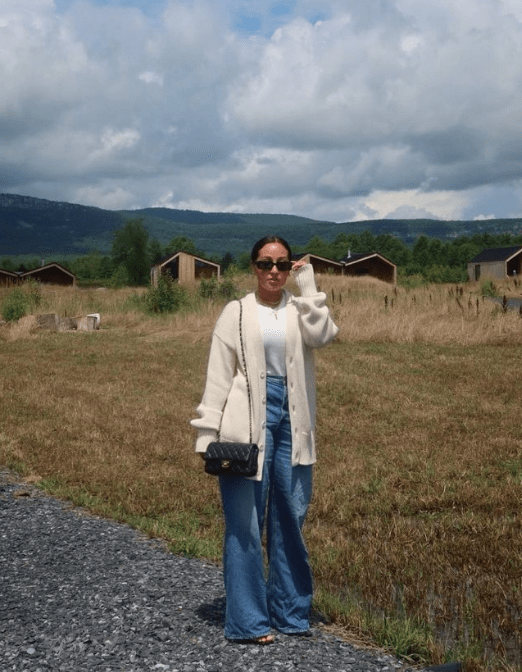A Fall Guide To Layering
Photo: adriennebailon
Fashion layering is a fantastic way to showcase your creativity, combining various garments to design outfits that are as stylish as they are versatile. From the comforting coziness of a cardigan draped over your favorite blouse, to the elegant poise of a jacket donned over a dress, the options are boundless. The ability to adapt your outfits according to the shifting weather while maintaining your unique style statement is the true beauty of mastering the art of layering, particularly in the transitional phase of fall.
Layering does more than merely enhance your aesthetic appeal. It provides the adaptability to create diverse outfits from a limited collection of pieces. More than this, it provides practical benefits. In the chillier months, layering allows you to bundle up for warmth and then adjust your attire according to the temperature variations throughout the day. From the interplay of colors, textures, and patterns, layering truly allows your style to flourish.
This guide will serve as your mentor, imparting the knowledge you need to grasp this versatile styling tool. We will explore how to transition between seasons effectively, how to choose the right pieces for your layers, and how to balance functionality with chic style. Prepare to elevate your fall fashion game and make the most of layering.
Getting to Grips with Layering Basics Decoding Layering in Fashion
Photo: kelsiebynum
Layering is a fashion tool that involves strategically arranging multiple pieces of clothing to construct a cohesive outfit. It allows you to play with textures, lengths, and styles, introducing depth and dimension to your look. Layering enables you to not only showcase your personal style, but also adapt to fluctuating weather conditions throughout the day.
Key Principles of Effective Layering:
To harness the full potential of layering, understanding the following principles is crucial:
Balance: Carefully consider the proportions of each layer to create a silhouette that flatters your body type. Try mixing shorter layers with longer ones, and fitting pieces with those that are more loose, to introduce visual interest.
Textural Variety: Inject a variety of textures into your outfits to introduce depth and dimension. Pair contrasting materials like silk with knit or denim with lace to enhance visual intrigue.
Color Harmony: Strive to select colors that work well together or create pleasing contrasts within your layered outfits. Experiment with monochromatic looks or complementary hues to achieve an outfit that is visually cohesive.
Choosing Fabrics for Layering
The choice of fabric can greatly impact the success of your layering. Focus on the weight, thickness, and breathability of each layer to maximize comfort and functionality. For base layers, breathable and lightweight fabrics such as cotton or linen work well, whereas thicker materials like wool or fleece are ideal for outer layers during colder weather. Flexible materials, like spandex or elastane blends, are fantastic for layering as they allow ease of movement.
Once you've internalized these layering basics, you'll be equipped to craft stylish, well-coordinated layered outfits. Layering is a powerful tool for expressing your personal style and adapting to a myriad of situations. Now, let's dive deeper into layering strategies tailored specifically for the cozy ambiance of fall.
Photo:kahlanabarfield
Crafting Layered Outfits for Fall
Layering during fall is about striking a balance between warmth and style. Here are some strategies to help you navigate this season:
Commence with a lightweight base layer such as a fitted long-sleeved top or a thin turtleneck.
Introduce a mid-layer like a plush cardigan or a chunky knit sweater for extra warmth.
Complete your look with a classic outer layer, such as a tailored wool coat or a quilted jacket, for the final touch of sophistication and protection from the crisp fall weather.
Utilize accessories such as scarves, gloves, and hats to add an extra layer of warmth while infusing texture into your ensemble.
Experiment with different lengths and textures to craft outfits that are both visually intriguing and functional.
Photo:@HannahBronfman
Visualizing a Fall Layered Outfit:
Create a warm and chic fall ensemble by layering:
Base layer: Fitted long-sleeved top or thin turtleneck
Mid-layer: Warm knit sweater or soft cardigan
Outer layer: Structured wool coat or quilted jacket
Accessories: Scarf, beanie, and ankle boots
Textural Play
Experimenting with different textures can significantly enhance the visual appeal of your layered outfits. For example, you can layer a soft cable-knit sweater over a smooth satin blouse, or pair a rugged leather jacket with a delicate lace top for a contrasting texture mix.
Layering Varying Lengths
An effective way to introduce dimension and visual interest to your outfit is by layering pieces of different lengths. Begin with a longer base layer like a tunic or a longline shirt. Add a mid-layer of a different length, like a cropped cardigan or a hip-length vest. Complete the outfit with an outer layer, such as a coat or a jacket, that either falls shorter or longer than the mid-layer to create a balanced silhouette.
Color Coordination
When layering, color coordination can make or break your outfit. Complementary colors can create a harmonious look, whereas contrasting colors can make a bold statement. Layer a navy sweater over a white button-down for a timeless combination, or pair a mustard yellow cardigan with a black turtleneck for a pop of color.







